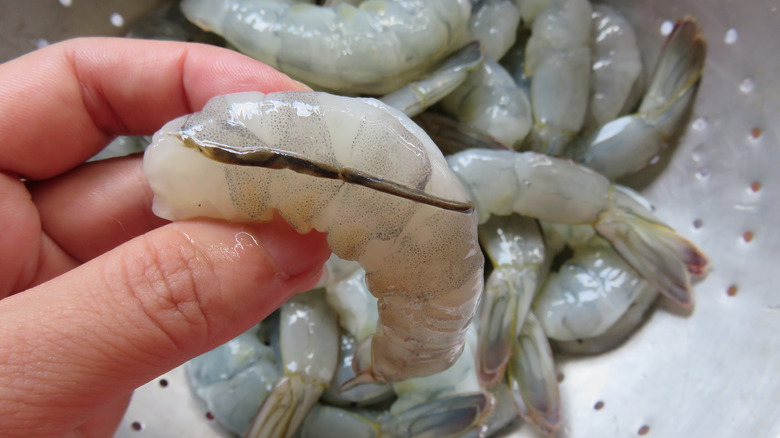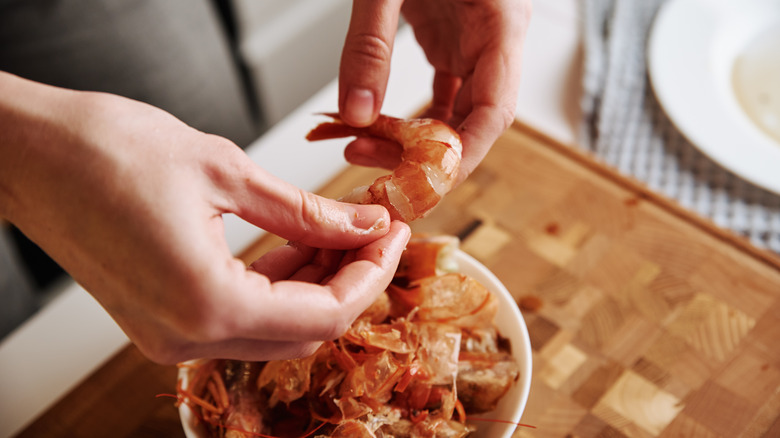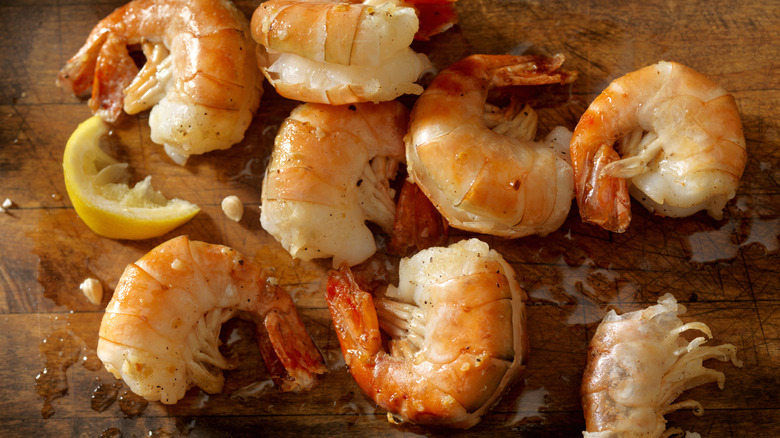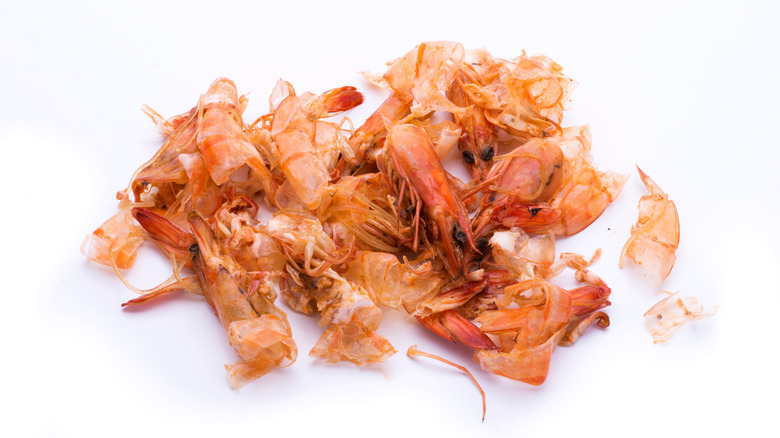In the United States, shrimp makes up more than 25% of all seafood consumed: It ranks number one in terms of amount with almost 6 pounds per person in 2021, according to Seafood Source. And it’s easy to see why. These delicious creatures of sea and freshwater inlets are a versatile and affordable protein featured in a wide variety of cuisines. Shrimp are quick-cooking, making them an uncomplicated addition to any hurried weeknight meal, down-home family gathering, or upscale affair.
Buying shrimp is complicated by a range of options, from the size of the shrimp to whether or not it comes with the head on. They can be peeled, sold in the shell, or exist in a confusing middle ground (EZ peel with the shell split and the vein removed). Shrimp are simple to cook with, but just getting them out of the store can be challenging for those who are new to seafood.
And preparing shrimp at home can be daunting if you don’t know what you’re doing. Peel on or off? Head on or off? And what to do about that dark line running down their back — and why doesn’t every shrimp have one? Not to worry. Peeling and deveining shrimp is simple. Here’s what you need to know.
What is the vein in shrimp, and do you need to remove it?

Nothing ruins perfectly cooked shrimp’s light, sweet taste like a gritty mouthful of undigested waste. Many cooks don’t know that there are actually two veins on a shrimp, both with different functions. The vein on a shrimp’s back gets the most attention. It’s the most obvious, often a thin black line running from just below the shrimp’s head to its tail. Not to put too fine a point on it, this vein is the shrimp’s intestinal tract that moves waste through the shrimp’s body, and you can guess what that might mean when it’s dark. A dark vein is unpleasant to consider and eat, but it can also be dangerous if consumed to excess in raw preparations.
The second vein is located on the underside of the shrimp’s body, running between its legs. This vein is a blood vessel (shrimp have white blood, which is why it seems clear). This vein does not need to be removed and will not affect the taste of even the simplest preparations.
Technically, when shrimp are cooked, neither shrimp vein needs to be removed. If you are not planning on eating a plateful of shrimp ceviche, though, you could safely leave the back vein in. Removing the vein is an added inconvenience in dishes with strong spices or flavors where shrimp are boiled in the shell or when the smallest shrimp are used (as in shrimp salad).
How to peel shrimp

If you have not purchased your shrimp either peeled or listed as “EZ peel” (split and deveined but with the peel still on the shrimp) and you are using them in dishes that require them to be chopped or eaten with a fork, you’ll need to get to work. Peeling shrimp is not hard; once you get the rhythm and technique down, you’ll be fine.
Start with thawed shrimp. The best way to thaw frozen shrimp is to let them defrost in the fridge in a colander set over a bowl to catch the water. If the heads are on the shrimp and you want them off, remove them first and set them aside. Hold the shrimp’s tail as you pull off the legs underneath the body, then loosen the shell near the (missing) head before peeling back towards the tail. If you want to keep the tail on, wiggle it slightly to break it away from the body shell, then remove the body shell.
Another alternative is to use scissors to cut along the back of the shrimp’s body, leaving the shell intact. This is a homemade EZ peel shrimp and is excellent if you want to keep the flavor of the shrimp shell as you cook.
Defrosted and peeled shrimp can be kept in the refrigerator for no more than two days and cooked shrimp for no more than four. Keep in mind that the quality will deteriorate as it sits.
How to devein shrimp

Once shrimp are peeled, it’s time to address the vein. It’s dirty, sticky work, but it will leave your shrimp tasting cleaner and fresher than if you left it in. Shrimp with the vein intact tend to taste muddy, reflecting a shrimp’s bottom-feeding behavior. There are a variety of ways to devein shrimp. If you plan on eating shrimp regularly, you’ll find one that works best for you.
Many chefs swear by kitchen shears. These work best on larger shrimp where shears will fit under the shell. Under cold running water, use your shears to make a cut through the shell along the shrimp’s back. This opens the vein and removes the shell in one go, cutting your prep time in half.
Others prefer to use a paring knife to remove the vein. On a peeled shrimp, carefully slide a sharp knife along the back of the shrimp. Open the cut with your thumbs and rinse to remove the vein. This technique must be done on an already peeled shrimp but works for various sizes.
The fiddliest technique of all uses a toothpick and a steady stream of water. Although it can be done on any size of shrimp, this technique is best for smaller shrimp that would be otherwise impossible to devein. Under cold running water and with a shelled shrimp, use a toothpick to tease the vein out gently. This can take a lot of patience and practice.
Do shrimp deveiners work?

Louella938/Shutterstock
If you are a big fan of acquiring every kitchen tool imaginable, a shrimp deveiner might work best for you. A shrimp deveiner is a thin plastic tool with a curve at the tip. The curve makes it easy to slide the device into the vein for removal. Multitasking shrimp deveiners can peel and devein at the same time.
To use a simple shrimp deveiner, peel the shrimp, then hold it with its back facing up. Insert the tool into the head end of the shrimp, right along the vein. Apply pressure and run the deveiner along the shrimp’s back, from head to tail. The flesh should separate, exposing the vein. When you reach the tail, the vein should lift out easily.
A deveiner designed to remove the shell works similarly — without first peeling the shrimp. This is the tool to use if you frequently cook peeled and deveined shrimp for a crowd. It’s safe and makes quick work of large amounts of shrimp. If you only eat shrimp on special occasions (and you like the large ones), save yourself $5 and use a different method.
But, whether you peel with a toothpick, shears, a knife, or a deveiner tool, keep hygiene a priority. Rinse and pat shrimp dry when the deveining is done.
Tail or no tail?

Imagine this: Your fork glides through a luxurious pile of fettuccine draped in a silky mornay sauce dotted with succulent pieces of chopped rock shrimp. You bite down, savoring the experience, when a strange crunch hits your teeth. The texture is a cross between a thin piece of rigid plastic and a frond of dried grass. You fish it out to find the remains of a shrimp tail. Leaving the tail of a shrimp on in a dish that requires a fork to eat is a no-no — not everybody wants to hunt around for shrimp before eating to cut the tail off.
On the other hand, appetizers and shrimp snacks designed to be eaten by hand need a handle and the tail is a perfect option. The shrimp tail is easy to hold onto and eliminates the need for silverware (or even plates, for that matter). Of course, it’s best culinary practice to cook shrimp when possible with the tail on. The shrimp shell is packed with flavor and will only add to your dish. Just be mindful when serving that not all preparations should feature a tail.
Should you leave the head on?

The shrimp head is full of delicious shrimpy taste and brings a depth of flavor to hearty dishes that give you full permission to put your elbows on the table, dig your hands into your bowl, and suck the juices out. If you are from a region where lip-smacking gumbo is featured on the table more often than not, this isn’t even a question that arises. Of course, you should leave the head on.
But there are some caveats here. In a raw shrimp, the head contains enzymes that immediately begin the decaying process once the shrimp dies. A head-on fresh shrimp has a very short shelf-life and should be sold, cooked, and eaten within days of its catch. Most of the IQF (and even the fresh shrimp) sold in the U.S. has the head removed to prolong the freshness and edibility of the shrimp.
And not everyone wants to dine with their dinner staring up at them. It’s essential to gauge the diners at your table to see if they might be okay when confronted with eyes and a face. Another consideration is the quality of the cook when a head is left on. For preparations that take a long time, cooking with the head on can lead to a mushy shrimp. Fat in the head releases and gives a remarkable taste (but a noticeable texture). Go headless if you like a nice bite and a lean final product.
Don’t throw out those shells

You’ve shelled and deveined a pile of shrimp. You’re left with a mound of shells and heads and no idea how to dispose of them. The worst thing you could do at this point is put them in the trash. That pile of shells can be turned into a delicately flavored seafood stock that makes the most delicious risotto or seafood stew you’ve ever tasted.
Start by heating oil in a large saucepan. Add shells and heads from one pound of shrimp and cook over medium-high heat for a few minutes. Stir frequently as they cook. Add 1-2 cups of water and a pinch of salt and bring to a simmer. Use a spoon or a spatula to press down on the shells as they simmer. Let the shells cook for about 7 minutes, then remove from the heat and strain. Press the shells as you strain to extract maximum flavor. Taste your stock and adjust the salt level to bring out the briny flavor.
This stock can be ladled into a jar and stored in the fridge for no more than four days or in the freezer for up to four months. If you don’t have time to make shrimp stock, pile all of your shells into a freezer bag. They’ll be ready to go when you are.
Getting started with shrimp

Shrimp is a versatile and (mostly) affordable lean protein. Many people first encounter fried shrimp baskets or shrimp scampi, but this crustacean is so much more than fried bites or heavy garlic sauce.
Around the globe, shrimp is used in various world cuisines, such as a highly spiced mofongo recipe from Puerto Rico or a subtle shrimp bisque recipe from France. Shrimp is also a surprising beef burger alternative, complete with a fresh zing of lemon and served on a grilled brioche bun.
If you are inexperienced with shrimp and aren’t sure if the flavor (or prep time) is right for you, the best thing to do is stay simple. Add a few grilled shrimp to your salad or mac and cheese. Nestle them in the twirls of spaghetti with red sauce, or add them to a favorite soup recipe. Shrimp loves sausage and takes on bold, hearty flavors with ease. Try a shrimp boil with sausage, potatoes, corn, and shrimp boiled in beer and Old Bay and dump it all out on a brown paper-covered table for hungry people to share.
Don’t let peeling and deveining hold you back. There’s no shame in pre-peeled shrimp. Toss a handful into your next recipe and see if it doesn’t become your signature dish.






